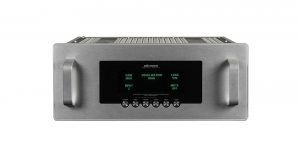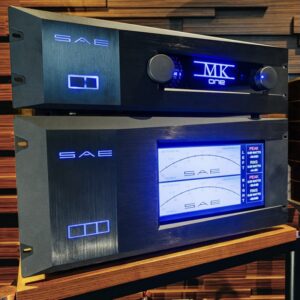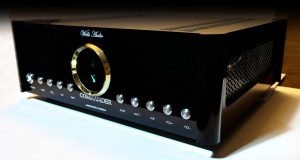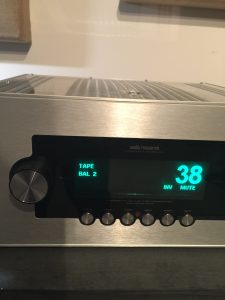The Japanese company Accuphase was set up in 1972 as Kensonic Laboratory, Inc. in Tokyo and after it moved to Yokohama in 1973, its products have born the Accuphase logo. It used to specialize in amplifiers and radio tuners, and later also in CD and SACD players. We are testing its latest, top-of-the-range C-3900 line preamp.
In the year 2010, on the occasion of its 40th anniversary, the Accuphase company launched its reference preamplifier C-3800 which was replaced with the C-3850 model in June 2016. Starting with the C-3900 that was launched last year, the company began celebrating its 50th anniversary by replacing all its flagship devices with new ones. The events will culminate in 2022, when the full "anniversary" reference system becomes available.
So, the C-3900 is the third generation of the flagship preamplifier. If we look at the photos of the models, we will notice that the changes on the outside are surprisingly small. It is similar in the case of technical specifications and functionality. As I have already written many times (and I have tested most products of this manufacturer in the last 15 years), Accuphase is a company that was set up and is managed by engineers. They are music lovers and the prototypes of new devices undergo listening tests, but the owners' actions are based on new technologies, or rather their slow evolution. This time it is no different.
C-3900
On the outside the new preamplifier resembles both previous models, C-3800 and C-3850 (tested in HF, respectively, HERE). I am not going to describe these differences in detail, but just tell you that, as always, they are related to improving the functionality of the devices, as well as slightly shifting stylistic accents.
From among the preamp's key features, the company mentions the following on its website:
- Dual Balanced AAVA volume control
- High-gain discrete current feedback type input amplifier
- ANCC technology minimizes noise and distortion
- Newly developed volume sensor construction
- Separate toroidal power transformers for the left and right channels
- Newly developed filtering capacitors
- Separate unit amplifiers for the left and right channels
- Printed circuit boards using glass cloth fluorocarbon resin
- Wood cabinet with natural grain finish
- High-performance headphone amplifier
I asked the Head of Engineering of the Accuphase company, Mr. Mark Masaomi Suzuki, who is responsible for each of the sections of the preamp. By his courtesy, you have been able to look at what has been happening behind the scenes for quite a long time, which is extremely rare in the case of Japanese companies.
A few simple words with…
鈴木雅臣
MARK MASAOMI SUZUKI
The team responsible for the C-3900: Mr. Itoh-san, Mr. Miyajima-san and Mr. Nakagawa-san (as seen from the left)
MECHANICAL DESIGN – ITOH-san
Mr. Itoh is 45 and has been working for Accuphase for 15 years. He was involved in the development of the C-3800, C-2450 and C-2150 preamps, the P-7300 power amp and other company products. Itoh-san loves the electric guitar and wants to be like John Frusciante and Eddie Van Halen 🙂 He cried buckets the day Eddie died...
CIRCUIT DESIGN AND SOFTWARE – NAKAGAWA-san
Mr. Nakagawa is 39 and has been working for Accuphase for 12 years. He helped develop the C-3800 and C-3850 preamps, the D/A DC-950 converter, the A-200 power amp and other products. At weekends, Nakagawa-san enjoys sword-fighting using a plastic toy sword with his 3-year-old son: a little samurai.
CIRCUIT DESIGN – MIYAJIMA-san
Mr. Miyajima-san is 35, so he is a young engineer. He is responsible for the company's signature ANCC technology: the Accuphase Noise and Distortion Cancelling Circuit that he came up with and developed, and which is being used in the C-3900 and other company products. Mr. Miyajima is an electric guitar and bass lover, as well as a great fan of Jaco Pastorius. MMS
TheC-3900 is a line preamp with a balanced signal path. It is quite a big device, partly because all the components, i.e. the amplifying and the power supply section, have been enclosed within one housing. It offers four balanced XLR inputs and six unbalanced RCA inputs plus an unbalanced recording loop. Next to these, there are four pairs of line outputs (2 x RCA and 2 x XLR), as well as a loop (RCA and XLR) for an external sound processor, e.g. for a room acoustics correction circuit.
The Look
The front panel made of thick aluminum has been gold anodized, which is typical for the manufacturer. The housing is multilayered, extremely rigid, made of aluminum and steel panels. Even thicker panels comprise a "skeleton" which divides the interior into functional sections: the PSU, left and right gain channels, logic, inputs. On the outside, there is also a steel-reinforced wooden casing.
The wood is an interesting element anyway, as it was possible in the 1970s to buy additional wooden casings for Marantz and McIntosh devices, while some Japanese companies would equip their top-of-the range devices with them as well. Back then, it was an element of design and nobody would relate it to sound. As time went by, when the basic problems had been dealt with and distortion had been minimized, it appeared that the mechanical structure of audio devices is of utmost importance and can be used to modify sound to large extent.
So, a lot of companies have great expectations connected with wood and equip their devices with integrated (or additional) platforms (e.g. SPEC, SoulNote, CLONES audio, or Phasemation), while some firms (e.g. Leben) add wooden sides to their gear. In the C-3900, wood performs both functions, i.e. "sound-shaping" and decorative. It features glossy finish and the top-layer fine wood has a different color than the previous models.
Functionality
The front panel of the device is defined by large input change and volume control knobs, a glass plate with displays underneath (related to the knobs), LEDs providing information on the settings and a manually opened lid where additional manipulators have been placed.
Using the knobs, one can choose an active input or just leave the headphone one on; select circuit gain, adjusting it to the given system (+12/18/24 dB); change balance between channels, as well as select the bass compensation level and headphone amplifier gain. The buttons allow us to turn off the displays, change the absolute phase, select the mono mode and start the analog recording loop.
What is interesting, the preamp does not feature phono stage or DAC slots. The designers of the C-3900 must have assumed that it would make the electrical properties of the circuit worse. However, there is a separate headphone amplifier for which we can select gain, adjusting it to the given headphones, including planar ones—the device provides sufficient current efficiency.
We also get a remote control as part of the whole set, one characteristic for the manufacturer (and so for the 1980s). It is made of gold-anodized aluminum and features buttons having distinctively different shapes (and colors) that are really easy to operate—this is how any remote control should work.
It is an example of a perfectly planned and made audio product.
The Way We Listened
The tested preamplifier was placed on the upper shelf of the Finite Elemente Master Reference Pagode Edition rack, on its own feet. They are made of high-carbon steel, which gives them anti-vibration properties.
The C-3900 is a balanced device, while I only use RCA cables in my system, as I believe they make it sound better. In order not to make things too complicated, the Japanese device was tested in exactly the same conditions, i.e. with the Siltech Triple Crown RCA cable from the Ayon Audio CD-35 HF Edition SACD player and the Crystal Cable Absolute Dream RCA cable from the preamp to the Soulution 710Na power amp. To justify myself, let me just tell you that signal from the RCA inputs is amplified independently and symmetrized on the AVAA input. As for power supply, the Harmonix X-DC350M2R Improved-Version cable was used.
While listening to the headphone amplifier, I used the HiFiMAN HE-1000 v2, Sennheiser HD800 and AKG K701 headphones with the "medium" gain level. Let me also add that the preamp operated with +12 dB gain during the test.
Albums used in the test selection
- GEORGE MICHAEL, Patience, Aegean | Sony Music UK 515402 2, CD (2004)
- JOHN COLTRANE QUARTET, Ballads, Impulse!/Universal Music LLC (Japan) UCCU-40001, Platinum SHM-CD (1962/2013)
- JOHNY CASH My Mother's Hymn Book, American Recordings B0002362-02 | Compact Disc (2004)
- LEONARD COHEN, Popular Problems, Sony Music Labels SICP-4329, CD (2014); review HERE
- MIKE OLDFIELD, Crises, Mercury/Universal Music Japan UICY-75880/1, 2 x SHM-CD (1978/2013)
- TAKESHI INOMATA, The Dialogue, Audio Lab. Record/Octavia Records OVXA-00008, SACD/CD (1977/2001)
- TSUYOSHI YAMAMOTO TRIO, Midnight Sugar, Three Blind Mice/Impex Records IMP8308, Gold HDCD (1974/2004)
Those of who who associate audio development with adrenaline and exclamations such as: "What a difference!," will be disappointed with the C-3900—not with the device itself, but with how its sound differs from the sound of the previous top-of-the range Accuphase preamp. I have not found anything in the sound of the new model that might give one such a shot of adrenaline, or make them shout out loud. And that is good—it is not the type of a company or this type of engineers. I would be surprised and worried otherwise.
That does not mean, however, that nothing has changed. The C-3900 is an unambiguously better device than the C-3850. The term "unambiguously" needs to be properly understood here—it will be meaningful only for the people who have immersed themselves in Accuphase products and are sensitive to any new vibration or color that they offer—those who consider moving a knob a few centimeters to the right or left to be a "revolution." For them, the C-3900 will definitely be a completely new device.
For those who have just entered this world or visited it only for a while, it will be more important to know that the C-3900 is a unique product. It produces massive and strong sound, with a low-set point of gravity. There has been a clear evolution in the company products over the years, from lighter and transparent sound to the density that we have now. What is interesting, it is mainly based on the technical changes that the Accuphase engineering team can measure and quantify.
So, the C-3900 gives us large and strong sound with deep bass. The bass guitar, double bass, percussion feet, low-set keys—we get all of it in Nevermind, a track from Leonard Cohen's album Popular Problems. The Japanese preamp gave the album tone color resembling what I know from the everyday experience of listening to the Ayon Audio Spheris III tube preamp. So, the treble is rather dark, but very selective—it does not impose itself, but has good resolution. The Accuphase preamp treats it in a more uniform way, at least when it comes to the placement of high tones in space, but it is a similar way of presenting.
The additional "weight" that I am talking about is mostly related to low bass. Its medium and higher range are really clear and transparent. So, the weight is not put in the middle of the range which is warm and velvety on one side, and quite open on the other side. While listening to Johnny Cash's album My Mother's Hymn Book, where we only have his vocal and the guitar, recorded using a minimalist setup, we will get sound characterized by good resolution, selective and open, but not too selective. It is not a device that splits hairs. Cash's vocal had large volume and the guitar was shown in the same line, as the C-3900 does not exaggerate with anything and does not force anything, either.
Our albums
JOHNY CASH My Mother's Hymn Book. American Recordings B0002362-02. Compact Disc (2004)
My Mother's Hymn Book is a collection of Christian songs that, as Johnny Cash says, his mother used to sing. It was part of a 4-disc box Unearthed with the base American Recordings album from the year 1994, which brought the artist back onto the music market.
It is a unique album, as it only features the artist's voice and his guitar. The material for the album was recorded in a little cabin that used to belong to his father, located behind the family house in Hendersonville, Tennessee. His father called the house the Cedar Hill Refuge and it is remembered as The Cabin. Even though it is the fourth album in the box, the material for it was recorded first, in mid-October 1993.
The person who helped Cash return to the studio was Frederick Jay "Rick" Rubin, the producer known for his cooperation with such famous stars as Public Enemy, Beasty Boys, The Cult, Danzig, Red Hot Chili Peppers, Mick Jagger, AC/C, Metallica, and others. He got eight Grammy awards and was nominated for fourteen more.
Rubin was known for his aspiration to simplify production, but also criticized for contributing to the so-called "loudness war"—his Californication (RHCP) and Death Magnetic (Metallica) albums are the infamous examples of this tendency. However, when recording with Cash, he changed his attitude and recorded the singer at one go, without additional gear, almost directly onto S-VHS tape—the material was recorded using Alesis ADAT multi-track tape recorders, working with 16-bit/48kHz signal.
The sound of the album is stunningly intimate. John Cash's voice has large volume and is wonderfully filled, just like the guitar—it is known that he played the Roseanne Cash Series Martin [OM-28] acoustic guitar, the so-called "Black Martin," the first such guitar produced with a black finish. Rubin is featured as the sound engineer and producer on the album, but the mix and master were dealt with by Vlado Meyer, a person Rubin couldn't stand. Apparently, he did not have much work, as the effect is unique, even though we are talking about a digital 16/48 recording!
The album is available as part of the abovementioned box, but it was also released separately in 2004. It is interesting that one of the tracks that are featured on another album from the box is a cover of "Personal Jesus" by Depeche Mode—one of the best and most religious interpretations of the song that I know.
Compared to the C-3900,the Reference preamp seems to be a little more "forward," as it puts more emphasis on 3D images and shows their texture better—but at a certain cost. This slightly violates the balance between what is in front of us and what is further away, but in high-end each little vibration is equal to an abyss. The Ayon preamp focuses on warmth and 3D images, due to which Cash's vocal was a little closer than the guitar, even though they were in one line during the recording.
Anyway, this is one of the most important advantages of the tested preamp—spatiality and the balance that is maintained within it. As has already been mentioned, the Accuphase C-3900 preamp weighs sound down, but does not flatten the perspective, or "ground" the musical message. That was clearly audible not only when I listened to Cash, but also to the opening track from Mike Oldfield's album Crises. It starts with sounds that surround and move around us. They were stronger, denser and clearer with the Japanese preamp.
Headphone Amplifier
One of the advantages of the C-3900 is the presence of a full-bodied headphone amplifier with adjustable gain. It is an unbalanced, but really high-quality section. It sounds more accurate than the line outputs. The best-made albums, e.g. The Dialogue by Takeshi Inomata, or Midnight Sugar by the Tsuyoshi Yamamoto Trio sound great. It is sound characterized by high resolution, accurate and incredibly dynamic.
The recordings that were not so perfectly made will lack a little "ground" or fill. This can be compensated for, however, when we use Audeze instead of HiFiMAN headphones. It is a compromise, but not a too painful one. It is worth doing, as we will not need an external headphone amplifier, unless we have 10,000 PLN spare cash or more—then go ahead!
So let me repeat: density, warmth, velvety sound, strong low bass, clarity and a great perspective. They are all pointing to one thing—well-balanced sound. Bass changes things about it a bit and gives it a personal touch. So, we get a musical message that does not flash or make us nervous, but is not bland or too "polite," either. The sound is also deep, which makes it seem distinguished. However, it is not encapsulated within a bubble of warmth—in the end, it is a precise and accurate device. However, the accuracy and precision that I am talking about do not shine through here through the separation of sounds, but by making them part of a coherent whole together with other sounds. This is a modern interpretation of technology which I find really attractive and consider to be right.
Albums such as the one by Mike Oldfield may sometimes sound too bright, or even penetrating. Multi-track analog recording with many additional actions in between (as when we record a few tracks of the percussion, for example, and then mix them to stereo and record them in such a way onto multi-track tape, thus saving tracks for other instruments) that not only raise the noise level, but also increase harmonic distortion. The best systems seem to ignore it, demonstrating good sound production and rich tone colors—so does the Accuphase preamp. It does not stop to focus on a detail, as the detail in itself has no meaning, but goes further and deeper.
Conclusions
So what does the Accuphase C-3900 sound like? On the one hand, I am talking about weighing sound down and, on the other hand, about openness—I emphasize the velvety character of the sound, but I must also add that the mid-bass is quite contoured and not as soft as the sound of tube devices. Finally, I praise the excellent spatiality, adding that 3D imaging is a little worse. So, how to put all of this together? Unfortunately, I won't help you do it, as we are talking about top high-end here, where dichotomies such as 'bad-good,' 'bright-dark,' 'high-low' are useless, and sound description needs to go against them.
The tested preamp is not as open as the previous preamplifier models from the same manufacturer, mainly ones from the 1990s and early 2000s, but not because we get fewer sounds with it, but due to the fact that there are more of them (!), thanks to which the sound is fuller and, ultimately, more natural. The C-3850 could already do that, but now we can hear that this can get even deeper, thanks to which sound is velvety on the one hand and characterized by high resolution and detailed on the other hand. These observations are confirmed by the excellent spatiality of the tested preamp.
The bass is strong and "burnt-in", which gives the musical message large volume and establishes it firmly on a strong base. It is a departure from absolute neutrality, but many music lovers and fans will like it. The tested Accuphase product is also an excellent headphone amplifier, which is worth taking into account, as well as it provides excellent functionality. This is simply top high-end, not only when it comes to sound, but also design and equipment—and this is a really rare, quite a unique combination. I think the preamp is worth listening to for a long time and in peace— and you will be impressed.
Well, I have no other choice, but to award the preamp with our highest distinction: the GOLD FINGERPRINT.
DESIGN
The tested preamp has dual mono designed, i.e. the left and right channel are completely separate, including the input section, where RCA connectors for the left and right channel are plugged in from the back to the main board. The whole design is based on this concept—the main boards constitute the basis, while individual circuit boards are connected to them using gold-plated industrial multi-pin connectors.
It allows one to separate individual sections from one another and to optimize mass—a thing that is both really difficult and important in circuits with broad frequency response. When taken out of the housing, the design resembles a skeleton of a large bulky fish.
The main difference between the C-3850 and C-3900 is the fact that a proprietary double balanced volume control circuit called DUAL BALANCED AVAA has been used in the latter. It is a circuit that adjusts the gain of a circuit without damping it—a characteristic feature of Accuphase devices, based on the company's own patent. In the C-3850 it was a balanced circuit, while here we have two such parallel circuits, which has made it possible to reduce the already very low noise level by as much as 30% (-130 dB!)!
A high-gain discrete current feedback type amplifier operates in the input stage. Such multi-stage circuits connected in series contribute to a drastic reduction of noise in the first gain stage—and such is the case here. Similar conclusions (i.e. high gain and volume control afterwards) were once drawn by GERHARD HIRT, who used a single high-gain tube on the input in the Ayon Audio Spheris III preamplifier and a transformer damper on the output. As you can see, some solutions are timeless and can be put into practice using different methods.
There is also a noise and distortion cancelling circuit called ANCC (Accuphase Noise Control & Distortion Cancelling Circuit) on the input of each AAVA module—a novelty. It is part of the current to voltage converter and detects harmful components of noise and distortion on the amplifier input, injecting the cancelling current of reversed polarity. It is equally effective at any volume level.
It is worth remembering that there is not a single variable resistor in the signal path and the whole path from the input to the output is symmetrical. A cutting-edge volume sensor equipped with a motor has been placed in a CNC-machined aluminum block. There is an extra-thick shaft (8 mm in diameter) and a set of gears mounted using a floating mechanism, with custom made grease ensuring smooth and super-quiet volume adjustment.
Technical specifications (according to the manufacturer)
- Frequency response 3-200 000 Hz (+0/-3 dB) | 20-20 000 Hz (+0/-0.2 dB)
• Total Harmonic Distortion (for all inputs): 0.005%
• Input sensitivity/input impedance: 252 mV/40 kΩ (XLR)
• Maximum input voltage: 6 V (XLR/RCA)
• Output voltage/output impedance: 2 V/50 Ω
• Maximum output voltage: (0.005% THD, 20-20 000 Hz) – line XLR/RCA: 7 V
• Signal-to-noise ratio: 115 dB (XLR/RCA)
• Crosstalk: > -90 dB (10 kHz/EIA)
• Gain: 18 dB
• Compensation:
1: +2 dB (100 Hz),
2: +4 dB (100 Hz),
3: +6.5 dB (100 Hz)
• Power consumption: 55 W
• Dimensions: 477 x 156 x 412 mm
• Weight: 25 kg
Price (in Poland): 144,900 PLN
Accuphase
Company contact details (for Europe): 2-14-10 Shin-ishikawa
Aoba-ku Yokohama | 225-8508 | JAPAN
MADE IN JAPAN
Text: WOJCIECH PACUŁA
Images: Wojciech Pacuła | Accuphase

















































